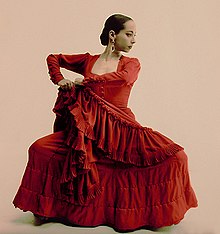ഫ്ലാമെങ്കൊ
സ്പെയിനിലെ പരമ്പരാഗതമായ ഒരു സംഗീത രൂപമാണ് ഫ്ലാമങ്കൊ. ഇത് സ്പെയിനിലെ അൻഡലൂഷ്യ പ്രവിശ്യയിലാണ് ഉൽഭവിച്ചത്. അൻഡലൂഷ്യൻ സംഗീതവും, റോമനി സംഗീതവും തമ്മിലുള്ള ഒരു സംയോജനത്തിൽ നിന്നാണിത് ഉടലെടുത്തത്. ഇതിന്റെ പ്രകടനത്തിൽ (performance) നാല് വിഭാഗങ്ങൾ ഉണ്ട്, അത് കാന്റെ (vocals), ടോക്കേ (ഗിത്താർ വായന), ബൈലേ (നൃത്തം), പൽമാസ് (കൈ കൊട്ട്) എന്നിവയാണ്.[1][2][3]
| ഫ്ലാമെങ്കൊ | |
|---|---|
| Stylistic origins | Andalusian and Romani |
| Cultural origins | Andalusia (Spain) |
| Typical instruments | Flamenco guitar, Classical guitar, palillos, palmas and cajón |
| Subgenres | |
| Nuevo Flamenco | |
| Other topics | |
| Music of Spain - Music of Andalusia Cante Chico - Cante Jondo - Cante Intermedio - Falseta  | |
2010 നവംബർ 16-ന് ഫ്ലാമങ്കൊ ലോകപൈതൃകമായി യുനെസ്കോ അംഗീകരിച്ചു.[4]
അവലംബം
തിരുത്തുക- ↑ In the book Cartas Marruecas by José Cadalso
- ↑ Ríos Ruiz notes that the origins and development of Flamenco are well documented: "the theatre movement of sainetes (one-act plays) and tonadillas, popular song books and song sheets, customs, technical studies of dances, and toques, musical scores, newspapers, graphic documents in paintings and engravings...in continuous evolution together with rhythm, the poetic stanzas, and the ambiance". Ríos Ruiz Ayer y hoy del cante flamenco, Ediciones ISTMO, Tres Cantos (Madrid), 1997, ISBN 84-7090-311-X
- ↑ See the third definition for "flamenco" in the Dictionary of Real Academia Española.
- ↑ "ആർക്കൈവ് പകർപ്പ്". Archived from the original on 2011-09-28. Retrieved 2013-01-11.